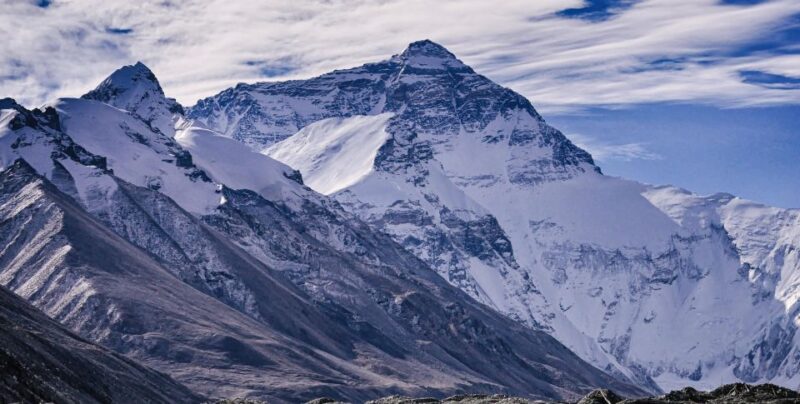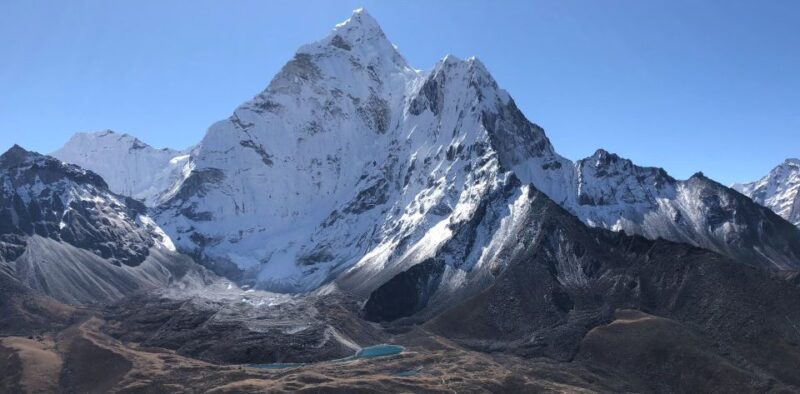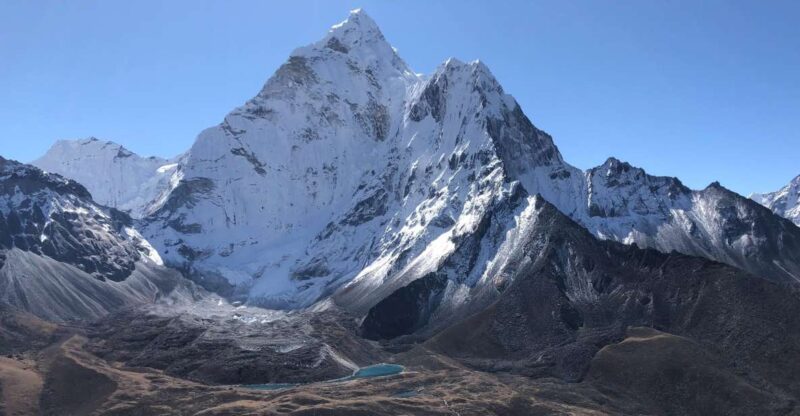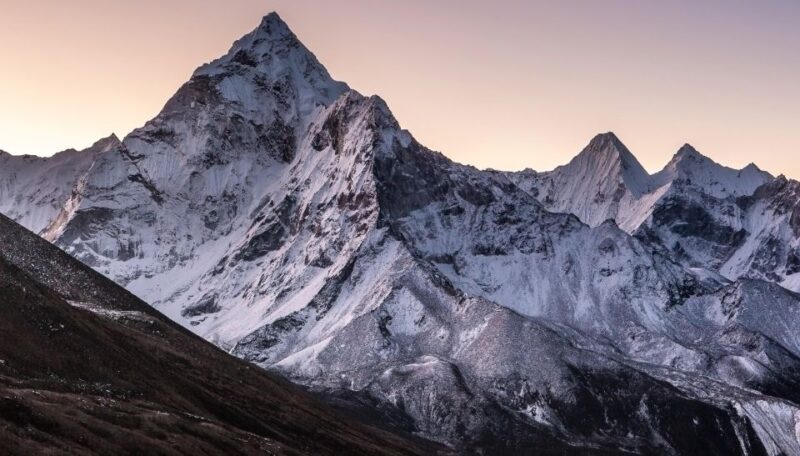Trekking in the shadow of the world’s highest mountain, Mount Everest, offers an unparalleled adventure for outdoor enthusiasts. Whether you’re seeking a challenging ascent or a more leisurely journey, the Khumbu region of Nepal provides a diverse range of trekking options to suit various fitness levels and preferences. From the Everest Base Camp Trek to the Everest Mini Trek, each route unveils a tapestry of Sherpa culture, breathtaking Himalayan vistas, and the opportunity to take in the awe-inspiring natural beauty that has captivated adventurers for generations. With optimal trekking seasons and a range of inclusions to consider, the path to your Everest experience awaits…
Key Points

- The Everest Mini Trek is a less demanding trekking option in the Khumbu region, featuring stunning views of the Himalayan range including Mount Everest.
- The trek starts with a flight to Lukla and follows trails along the Dudhkoshi River, with key stops at Phakding, Monjo, and Namche Bazaar.
- The optimal trekking seasons are spring (February-May) and autumn (September-November), offering mild weather and clear skies for excellent visibility.
- The trek package includes round-trip flights, necessary permits, experienced guides and porters, comfortable twin-sharing lodges, and all meals to ensure a seamless trekking experience.
- Trekkers are responsible for their own travel insurance, personal equipment, and tipping, which are not included in the trek cost.
Trekking Overview

The Everest Mini Trek offers a less demanding trekking experience for those unwilling to venture into high-altitude regions above 5,000 meters. This trek provides stunning views of the Khumbu region and the majestic Himalayan range, including the iconic Mount Everest.
The journey begins with a flight to Lukla, followed by trails along the Dudhkoshi River. Along the way, trekkers will make stops at Phakding, Monjo, and the vibrant Namche Bazaar.
Trekkers also have the option to hike to the Khumjung Village before returning to Lukla for the flight back to Kathmandu.
The best trekking seasons are spring (February to late May) and autumn (September to November). Summer and winter are less favorable due to monsoons and extreme cold, respectively.
Ready to hit more trails? More hiking adventures we feature in Namche Bazar
Itinerary Details

The Everest Mini Trek journeys commence with a flight from Kathmandu to the small airstrip at Lukla, situated at an elevation of 2,840 meters.
From Lukla, trekkers embark on a scenic trail that winds along the banks of the Dudhkoshi River, making stops at the quaint villages of Phakding and Monjo.
The highlight of the trek is the arrival at the bustling Namche Bazaar, a lively hub for Sherpa culture and the gateway to the Khumbu region.
Trekkers have the option to hike to the nearby Khumjung Village before returning to Lukla for the flight back to Kathmandu.
The trekking seasons are typically in the spring and autumn, offering the best weather and views of the Himalayan landscape.
Pricing and Payment

What’s the price for the Everest Mini Trek? The tour is priced from £1,153.94 per person. Travelers can reserve their spot without any upfront payment, and cancellations up to 24 hours in advance qualify for a full refund.
The pricing for this trek includes:
-
Option to reserve now and pay later.
-
Free cancellation up to 24 hours in advance.
-
No hidden fees or surprise costs during the tour.
This flexible payment structure and generous cancellation policy make the Everest Mini Trek an attractive option for those seeking a hassle-free booking experience.
Whether you’re an experienced trekker or a first-time adventurer, the competitive pricing and convenient payment options ensure an accessible and enjoyable journey.
Accommodation and Meals
Along with the flexible payment options, the Everest Mini Trek also includes a comprehensive package for accommodations and meals during the trek.
During the trek, trekkers will stay in twin-sharing lodges, where seasonal fruits are provided. All meals – breakfast, lunch, and dinner – are included, with tea and coffee served. The experienced guide and porters are also provided with food and accommodation, ensuring a seamless experience.
Back in Kathmandu, trekkers will enjoy three nights of accommodation in a 3-star hotel, with breakfast included.
With these inclusions, trekkers can focus on enjoying the stunning Himalayan views and the journey, without worrying about the logistics of food and shelter.
More Great Thing To Do NearbyTrek Inclusions
The Everest Mini Trek package includes a comprehensive array of services to ensure a seamless and enjoyable trekking experience. The tour includes:
-
Round-trip flights between Kathmandu and Lukla, along with all necessary permits and park fees.
-
Experienced, multilingual guides and porters to carry your luggage, providing support and expertise throughout the trek.
-
Comfortable, twin-sharing lodge accommodations and full-board meals, including tea and coffee, to keep you energized during the journey.
These inclusions, combined with the breathtaking scenery and the opportunity to explore the Khumbu region, make the Everest Mini Trek a truly remarkable experience for those seeking a high-altitude adventure without the demands of a full-fledged Everest expedition.
Trek Exclusions
Aside from the comprehensive inclusions, the Everest Mini Trek also has several exclusions that trekkers should be aware of and prepare for accordingly.
Meals not specified in the itinerary, such as extra snacks or drinks, aren’t covered.
Trekkers will also need to arrange for their own travel insurance and Nepal entry visa, which can be obtained upon arrival.
Plus, personal trekking equipment like sleeping bags, hiking poles, and warm clothing must be provided by the participants.
Lastly, tips for the staff, including guides and porters, aren’t included in the package price and are left to the discretion of the trekkers.
Tour Logistics
Travelers embarking on the Everest Mini Trek can expect a seamless and well-supported experience, with pickup included and a dedicated live tour guide available in multiple languages.
The tour logistics provide ample support throughout the journey:
-
Pickup is included, with guests waiting in the hotel lobby for just 10 minutes before the scheduled departure time.
-
Expert guides fluent in English, Hindi, French, German, Abkhazian, Arabic, Chinese, Japanese, Spanish, and Korean are on hand to lead the trek and provide insightful commentary.
-
While itineraries may be subject to change, the highlights of the trek, including scenic viewpoints, safety briefings, and guided tours, are consistently maintained to ensure a memorable experience.
Trekking Seasons
While the Everest Mini Trek can be undertaken year-round, the most favorable trekking seasons are spring (February to late May) and autumn (September to end of November). During these periods, the weather is generally mild, with clear skies and moderate temperatures, making the trek more enjoyable. The summer months (June to August) bring the monsoon rains, which can make the trails muddy and increase the risk of landslides. Winters (December to January) are bitterly cold, with the possibility of heavy snowfall, posing additional challenges for trekkers. The table below outlines the key factors to consider when choosing the ideal trekking season:
| Season | Weather | Visibility | Crowds |
|---|---|---|---|
| Spring | Mild, clear skies | Excellent | Moderate |
| Autumn | Mild, clear skies | Excellent | Moderate |
| Summer | Wet, rainy | Poor | Low |
| Winter | Cold, snowy | Good | Low |
Frequently Asked Questions

What Are the Permit Requirements for the Everest Trek?
The trekking permits required are the Sagarmatha National Park permit and the Trekkers’ Information Management System (TIMS) card. These permits are included in the tour package and arranged by the experienced guide for the trekkers.
How Difficult Is the Everest Mini Trek Physically?
The Everest Mini Trek is a moderate-difficulty trek that doesn’t require high-altitude hiking. It’s suitable for relatively fit trekkers, though it still involves several days of hiking through mountain trails. Proper preparation and acclimatization are essential to complete the trek comfortably.
Can I Hire a Private Porter for the Entire Trek?
Yes, trekkers can hire a private porter for the entire trek. Private porters are available upon request and provide dedicated assistance with carrying luggage, allowing trekkers to focus on the hiking experience.
Are There Any Age Restrictions for the Everest Mini Trek?
There are generally no age restrictions for the Everest Mini Trek, but it’s recommended that trekkers be in good physical condition as the trek involves moderate hikes. The tour operator can provide guidance on suitability based on an individual’s fitness level.
What Is the Maximum Group Size for the Everest Mini Trek?
The maximum group size for the Everest Mini Trek is typically 12 trekkers. This allows for an intimate and personalized experience while ensuring proper guidance and support from the experienced trek leader and porters throughout the journey.
Recap
The Everest Mini Trek offers an unparalleled opportunity to experience the grandeur of the Himalayan range.
Trekkers can enjoy Sherpa culture, marvel at breathtaking mountain vistas, and challenge themselves along scenic trails.
With optimal trekking seasons, comfortable accommodations, and all-inclusive packages, this adventure provides a truly memorable and accessible way to explore the wonders of the Everest region.
You can check if your dates are available here:More Hiking & Trekking Tours in Namche Bazar
More Tour Reviews in Namche Bazar
Not for you? Here's more things to do in Namche Bazar we have recnetly reviewed
- 4 Best Tours In Namche Bazar
- 6 Best Helicopter Flights And Tours In Namche Bazar
- 8 Best Hiking And Trekking Tours In Namche Bazar
- Mt.Phari Lapcha Peak Climbing
- Mt.Kyazo Ri Peak Climbing
- Everest Base Camp Tour
- Everest Base Camp Trek 12 Days
- Everest Base Camp Trek With Helicopter Return
- Lobuche East Climbing
- Mt.ABI
- Ride Horse to Everest Base Camp
- Everest Three High Passes Trek: 17-Day Guided 3 Passes Trek
